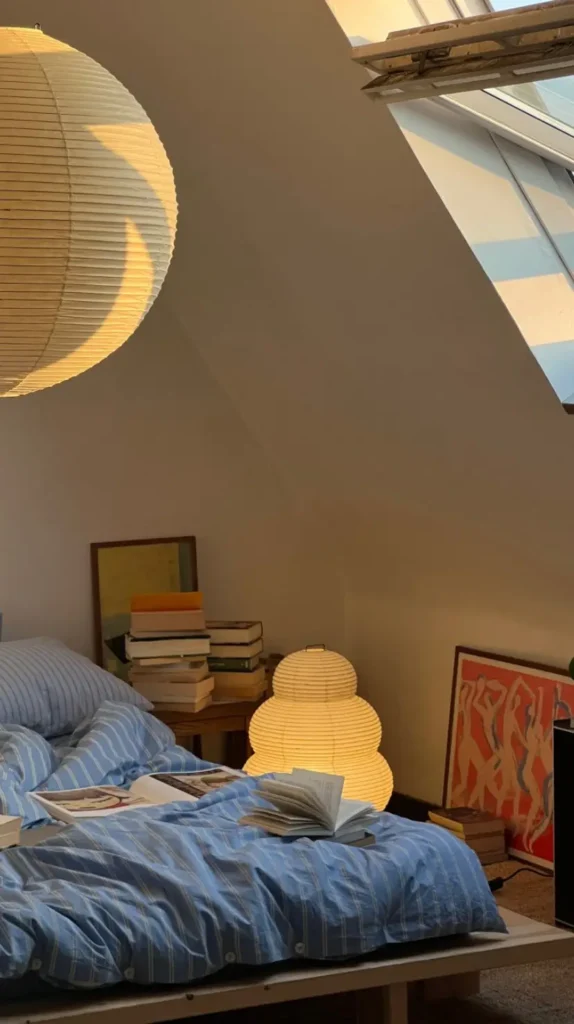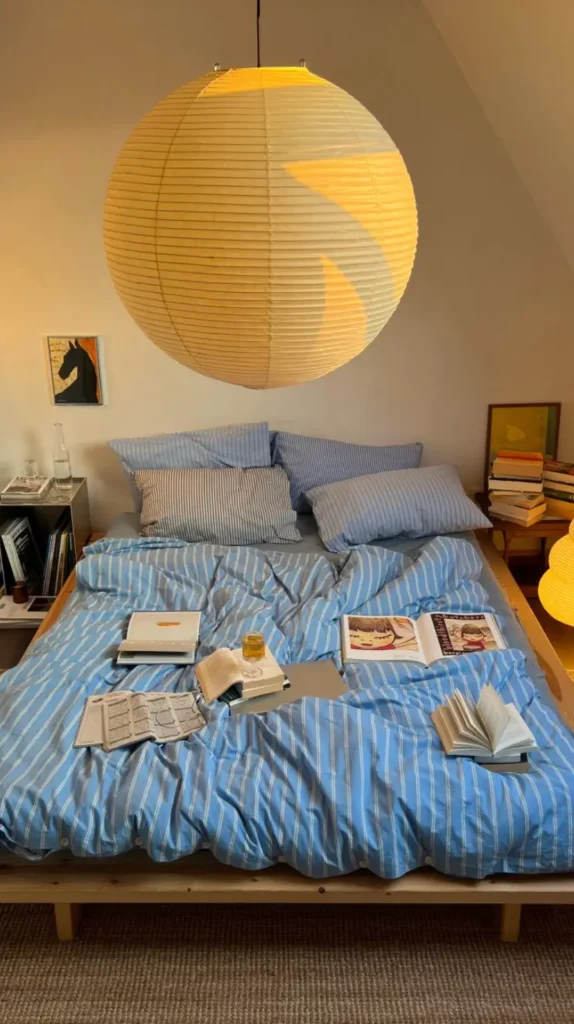Creating a serene and peaceful bedroom is essential for a restful night’s sleep. Inspired by the calming principles of Zen, a Japanese inspired bedroom can be a haven of tranquility in your home.
Characterized by minimalism and a connection to nature, a Zen bedroom encourages relaxation and rejuvenation. To bring this sense of calm into your home, consider incorporating natural materials and subtle color palettes into your bedroom design.
The Philosophy Behind Japanese Bedroom Design
At the heart of Japanese bedroom design lies a rich philosophical foundation that values simplicity and natural beauty. This design ethos is not merely aesthetic but is deeply rooted in traditional Japanese philosophies that promote a serene and mindful living environment.
Wabi Sabi: Embracing Imperfection
Wabi-Sabi is a core element of Japanese aesthetics that celebrates the beauty of imperfection and impermanence. It encourages an acceptance of the transient nature of life and the beauty found in the worn and weathered. In the context of a Japanese bedroom, Wabi Sabi can be applied by incorporating natural, unprocessed materials and embracing the unique character of each piece of furniture or decor.
Ma: The Importance of Negative Space
Ma refers to the void or the space between things, emphasizing the importance of negative space in design. In a Japanese bedroom, Ma is crucial for creating a sense of calm and visual balance. By thoughtfully incorporating empty space, the room feels more expansive and serene, allowing for a deeper connection to the self and the surroundings.
- Creating Balance Through Emptiness – Creating balance through emptiness involves carefully considering what to leave out, rather than what to include.
Essential Elements of a Traditional Japanese Bedroom
To create a tranquil retreat, traditional Japanese bedrooms rely on a few essential elements that promote relaxation and harmony. These elements work together to create a calming environment that fosters rest and rejuvenation.

– Natural Materials and Textures
Natural materials such as wood, bamboo, and paper are commonly used in traditional Japanese bedrooms. These materials bring warmth and texture to the space, creating a cozy and inviting atmosphere. The use of natural textures also helps to connect the indoors with the outdoors.
– Minimalist Furniture Choices
Minimalist furniture is a hallmark of traditional Japanese design. Low profile beds, simple nightstands, and minimal decor allow for a sense of openness and flow. This minimalist approach also helps to reduce clutter and promote a sense of calm.
– Neutral Color Palettes
Neutral color palettes are characteristic of traditional Japanese bedrooms. Soft shades of beige, gray, and taupe create a soothing backdrop for the natural materials and minimalist furniture. These calming colors help to promote relaxation and serenity.
Creating the Perfect Japanese Bedroom Layout
To create a serene Japanese bedroom, it’s essential to thoughtfully plan the layout. A well-designed layout not only enhances the aesthetic appeal but also promotes a sense of tranquility and relaxation.
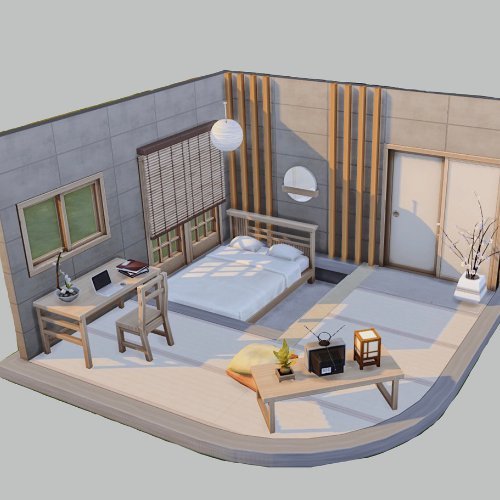
Optimal Furniture Placement for Flow
Optimal furniture placement is crucial for maintaining a smooth flow in the bedroom. In a traditional Japanese bedroom, furniture is often minimalist and carefully positioned to create a sense of harmony. Placing the bed in a commanding position, away from the door but with a clear view of it, is a good starting point. Additionally, consider the path you take through the room and ensure that it’s unobstructed.
Maintaining Open Space and Pathways
Maintaining open space and pathways is another vital aspect of a Japanese bedroom layout. Clutter and overcrowding can disrupt the peaceful ambiance, so it’s essential to keep the floor clear and use storage solutions that are out of sight.
Traditional Japanese Bedroom Furniture to Consider
To create an authentic Japanese bedroom, it’s essential to select traditional furniture pieces that embody the spirit of minimalism and harmony with nature. The right furniture not only enhances the aesthetic appeal of the room but also contributes to a serene and peaceful environment.
Futon Beds vs. Platform Beds
Source – karup_design
Futon beds and platform beds are two popular options for Japanese bedrooms. Futon beds are traditional and involve placing a futon mattress on the floor, often on tatami mats. This setup is not only space-efficient but also promotes a minimalist lifestyle. Platform beds, on the other hand, offer a more modern take by elevating the mattress on a low-profile platform, still maintaining the minimalist aesthetic.
Read – Futon Bedroom
– Tatami Mats and Their Benefits
Tatami mats are a traditional element of Japanese flooring, made from woven grass or reeds. They provide a natural, earthy feel to the bedroom and are known for their comfort and insulation properties. Using tatami mats under a futon bed can enhance the overall Japanese ambiance of the room.
Low-Profile Nightstands and Storage Solutions
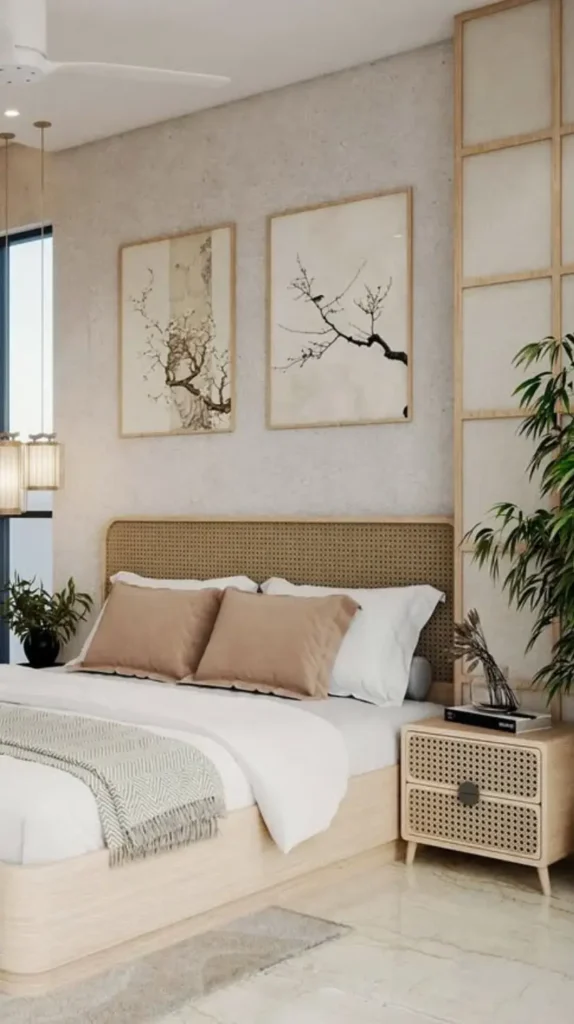
In a traditional Japanese bedroom, nightstands and storage solutions are designed to be low-profile, maintaining the minimalist and uncluttered feel of the room. Low wooden or bamboo nightstands and storage chests are ideal for keeping the room tidy while adhering to the traditional Japanese aesthetic.
Shoji Screens and Room Dividers
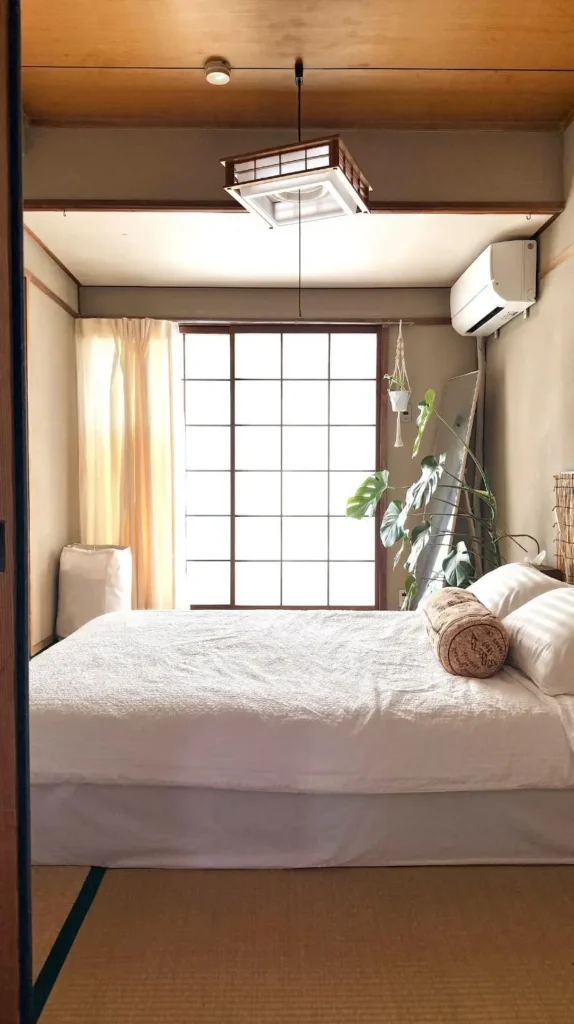
Shoji screens are another traditional element used in Japanese bedrooms. Made from rice paper or thin wood, these screens are used to divide the room or as window coverings, allowing soft, diffused light to enter. They add a layer of privacy and contribute to the serene ambiance of the bedroom.
Japanese-Inspired Bedding and Textiles
Japanese inspired bedding and textiles play a crucial role in transforming your bedroom into a peaceful retreat. The right choices can elevate the serenity and aesthetic of your bedroom, making it a true sanctuary.
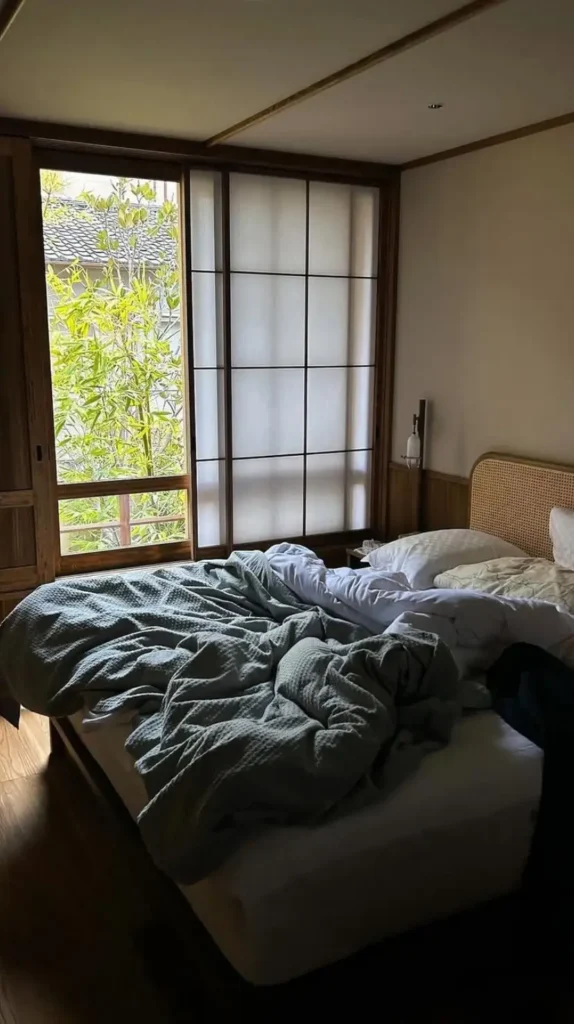
Choosing the Right Futon or Mattress
Selecting an appropriate futon or mattress is the foundation of creating a Japanese-inspired bedroom. Traditional Japanese futons are placed directly on the floor, providing a simple and minimalist sleeping solution. For those who prefer a more modern approach, a low-profile mattress on a platform bed can achieve a similar look while offering additional comfort.
Linen Selection and Layering Techniques
The selection of linens is another critical aspect. Opt for natural fibers such as cotton or linen, which are breathable and soft against the skin. Layering techniques should emphasize simplicity; start with a simple sheet, add a lightweight blanket or comforter, and finish with a few decorative throws if desired. This layered approach not only adds warmth but also texture and visual interest.
Decorative Cushions and Throws with Japanese Motifs
Decorative cushions and throws featuring traditional Japanese motifs can add a touch of authenticity to your bedroom. Look for designs that incorporate natural elements, such as cherry blossoms or bamboo, which are common in Japanese decor. These elements can be used sparingly to add pops of color and cultural significance to your bedroom.
Lighting Ideas for Your Japanese Bedroom
The right lighting can transform your bedroom into a tranquil Japanese-inspired oasis. Lighting plays a crucial role in creating the serene ambiance characteristic of Japanese bedrooms.
Source – finnishdesignshop
Paper Lanterns and Pendant Lights
Paper lanterns and pendant lights are traditional Japanese lighting elements that can add a touch of authenticity to your bedroom. These fixtures come in various sizes and designs, allowing you to choose the ones that best fit your space and decor. For a more authentic look, consider using lanterns made from washi paper or silk.
Natural Light Optimization with Sheer Curtains
Maximizing natural light is another key aspect of Japanese bedroom lighting. Sheer curtains or shoji screens can help filter the sunlight, creating a soft, gentle glow within the room. This approach not only illuminates the space but also maintains the serene and calm atmosphere.
Evening Ambiance with Candles and Soft Lighting
As the day transitions into night, candles and soft lighting can create a warm and inviting ambiance. Using candles with natural wax, such as soy wax or beeswax, can add a pleasant, subtle scent to the room. Soft lighting fixtures with warm tones can further enhance the cozy atmosphere, making your bedroom a perfect retreat.
Incorporating Nature into Your Japanese Bedroom
Nature plays a pivotal role in Japanese culture, and this is reflected in the design of traditional Japanese bedrooms. By incorporating natural elements, you can create a serene and calming environment that promotes relaxation and tranquility.
Indoor Plants for Tranquility and Air Purification
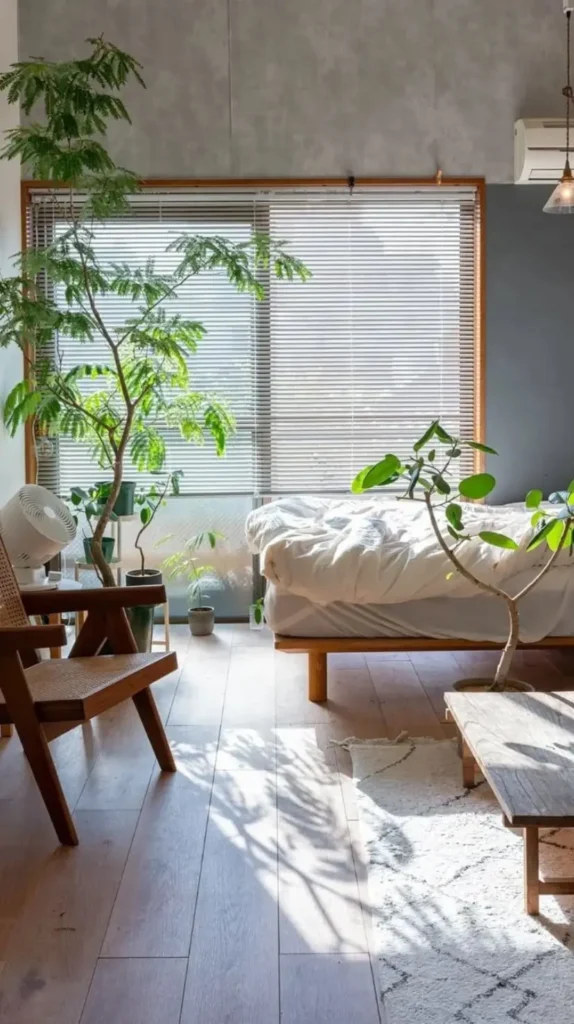
Indoor plants are a simple yet effective way to bring nature into your Japanese bedroom. Not only do they purify the air, but they also add a touch of greenery to your space, creating a sense of calm and serenity. Choose low-maintenance plants like succulents or moss that thrive in indoor conditions.
– Bonsai Trees and Their Symbolism
Bonsai trees are a classic element in Japanese decor, symbolizing harmony, balance, and patience. These miniature trees can be trained to thrive in containers, making them perfect for indoor spaces. By incorporating a bonsai tree into your bedroom, you can add a touch of natural beauty and symbolism to your space.
Natural Wood Elements and Bamboo Accents
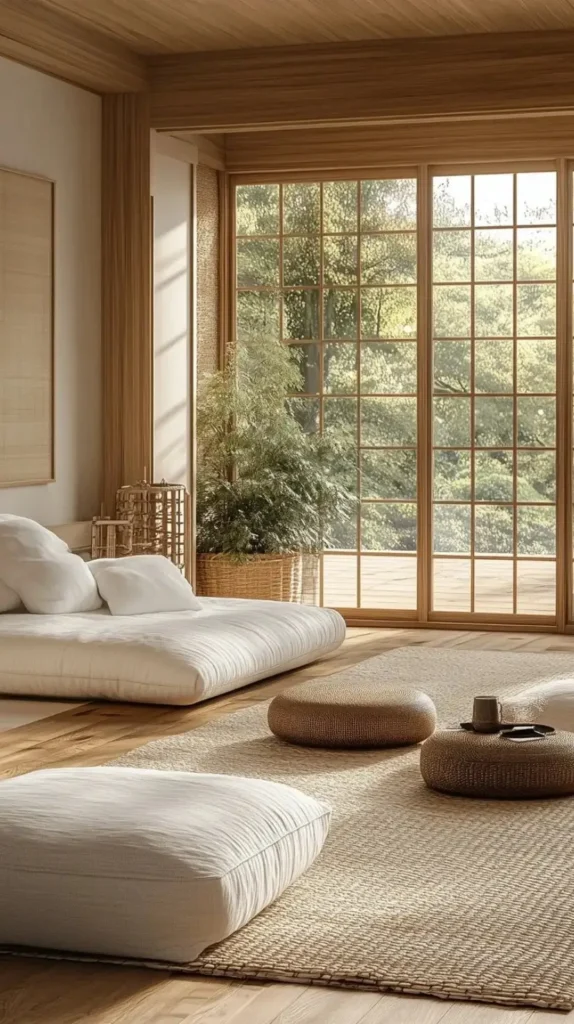
Natural wood elements and bamboo accents are integral to Japanese design, adding warmth and texture to your bedroom. Consider incorporating wooden furniture or bamboo blinds to bring a sense of the outdoors into your space. These natural materials can also help to create a cozy and inviting atmosphere.
Stone and Water Features for Meditation
For a more immersive experience, consider incorporating stone or water features into your Japanese bedroom. A small fountain or a bowl of river rocks can create a soothing, meditative ambiance, helping you to relax and unwind. These natural elements can also help to mask background noise, promoting a restful night’s sleep.
DIY Japanese Bedroom Projects on Any Budget
Transforming your bedroom into a serene Japanese oasis doesn’t have to break the bank. With a little creativity and some DIY spirit, you can create a peaceful and inviting space that reflects the simplicity and elegance of Japanese design. Here are some budget-friendly projects to get you started.
Handmade Paper Lanterns and Wall Art
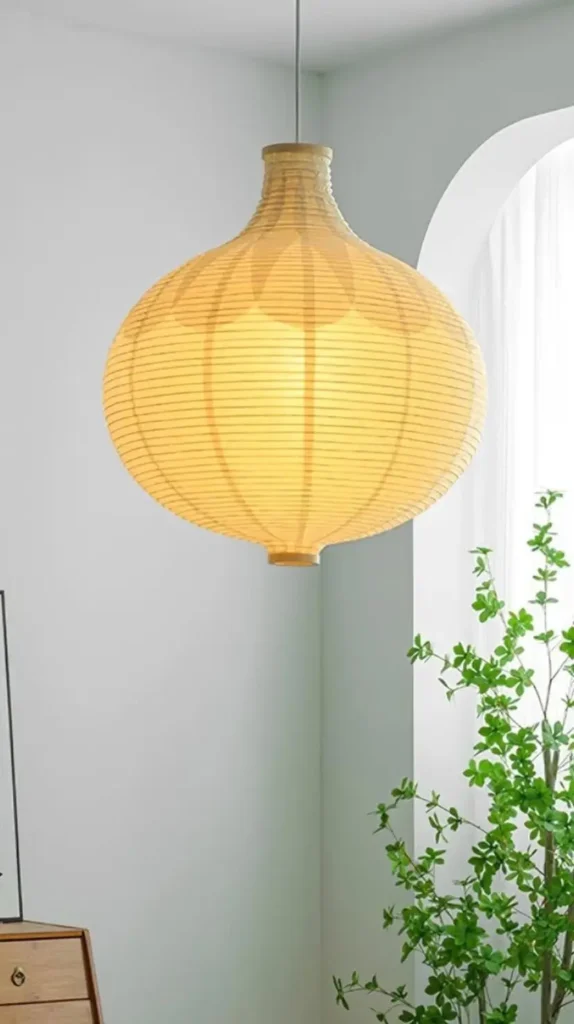
Paper lanterns are a staple in Japanese decor, adding a soft, warm glow to any room. You can create your own using rice paper and a simple frame. For wall art, consider making a Japanese inspired collage using natural materials like leaves, twigs, and fabric. These projects not only add visual interest but also bring a touch of handmade charm to your bedroom.
Upcycled Furniture with Japanese Aesthetics
Upcycling old furniture is a great way to give your bedroom a Japanese makeover on a budget. Look for pieces that can be refinished or repurposed with a minimalist, natural aesthetic. For example, an old wooden dresser can be sanded down and stained to resemble the natural wood tones often used in Japanese furniture. Adding simple, sleek hardware can further enhance the Japanese look.
Weekend Projects for Japanese-Inspired Decor
If you’re looking for quick and easy DIY projects, consider making a Japanese style headboard using fabric or bamboo, or creating a simple stone or pebble arrangement on a bedside table. These small touches can make a big difference in creating a cohesive Japanese inspired look in your bedroom. You can also try your hand at making traditional Japanese items like washi paper decorations or simple ikebana flower arrangements.
Modern Japanese Bedroom Ideas for Contemporary Homes
To achieve a Zen like atmosphere in your contemporary home, consider embracing modern Japanese bedroom ideas. This design approach combines the serenity of traditional Japanese aesthetics with the functionality of modern living.
Blending Traditional and Modern Elements
The key to a successful modern Japanese bedroom lies in striking a balance between traditional and modern elements. Incorporate natural materials like wood and bamboo alongside modern furniture pieces to create a harmonious space.
Space-Saving Solutions for Small Bedrooms
In smaller bedrooms, utilize multi-functional furniture, such as storage beds or wall-mounted shelves, to keep the floor clear and maintain a sense of openness. Consider using sliding doors or shoji screens to divide the space effectively.
Transform Your Space with These Japanese Bedroom Styling Tips
Creating a serene Japanese-inspired bedroom is all about balance and harmony. To achieve this tranquil atmosphere, focus on incorporating natural materials, minimalist furniture, and neutral color palettes. By combining these elements, you can create a calming environment that promotes relaxation.
Start by selecting a few statement pieces, such as a futon bed or a shoji screen, to anchor your space. Then, add layers of texture with linen bedding and woven baskets. Don’t forget to optimize natural light with sheer curtains and add warmth with candles or soft lighting in the evening. By implementing these japanese bedroom styling tips, you’ll be well on your way to a bedroom transformation that embodies the principles of Zen.
To further enhance your space, consider incorporating elements of nature, such as indoor plants or a natural wood headboard. By thoughtfully combining these elements, you can create a harmonious and calming bedroom environment that feels like a serene oasis.



